The Stamford Historical Society Presents
Pride and Patriotism: Stamford’s Role in World War II
Online Edition
The Interviews
Caleb Rodney Gibson
Rodney Gibson joined the Army Air Corps in 1942. He served in the ground crew for fighters in the 340th Fighter Squadron. He served primarily in New Guinea with the job of keeping his fighter plane in the air. Although, he did not fly, he was close to the battle as the Japanese regularly flew missions to harass Allied Bases in New Guinea.
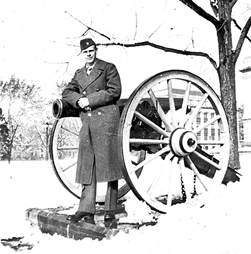 First of all what were you doing before you entered the service?
First of all what were you doing before you entered the service?
When war was declared I was a sophomore in college and I had been interested in the Air Corps for a long time and it was the Army Air Corps in those days and so at the urging of my father and my mother doing the opposite I decided I would finish my sophomore year of college and then enlist which is what I did, as you can tell by the serial number 12095686 that tells you that those are people who volunteered for WWII.
Why did you want to enlist?
Because I was interested in the Air Corps. I didn’t want to be in the infantry or the rest of it as it turned out it was a good thing I did. I loved the Air Corps-it had its good and bad moments.
Now what year was it when you enlisted? What month, year…where are we in time?
Early 1942…middle 1942…
Tape lost…
RG tells how he went to Fort Dix for Air Corps training…wanted to fly but the air corps only took men with perfect vision 20/20
You had to have perfect eyesight for they wouldn’t take you. I was 20/30 in my right eye, can you guess what it is today?...20/400. I can’t even see you out of my right eye. Luckily I have 20/20 in my left eye so I can drive.
Alright so they sent you then from Ft. Dix down to Miami Beach.
So for how long were you at Ft. Dix, was there training involved there?
Just the introduction basic training.
Tape lost…
at Miami Beach about three months.
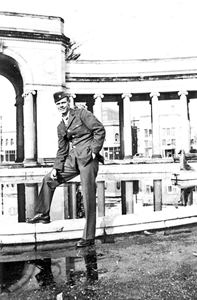 Tape lost…
Tape lost…
TZ Asks about what they did at Miami Beach, whether they started being trained on specific tasks…
There was no speciality, the speciality came when they found out that I could fly or they wouldn’t let me fly and asked me what I wanted to do and I said well, I’ll keep the airplanes in the air, and take care of the armament so they said, “Alright we will send you to Buckley Field in Colorado next to Denver and there you’ll learn how to be an armorer.” Now most people don’t know what an armorer is, they do know in the Navy its ordnance is what they call it but an armorer for anyone who is not familiar with that is the fellow who takes care of the guns, the ammunition, the gun sites, the rockets, anything explosive is what we took care of. So that’s what I studied for three months in Buckley Colorado. Buckley Field Colorado. Next to…Aurora.
Well after that we came back to the east coast and for a few weeks or months we spent some time up in Massachusetts that was just prior to going on ships in New York harbor and then out New York harbor. We didn’t know where we were going but all I know is that I was seasick all the way down because of a little tiny thing called a Liberty ship in those days, just a bucket of rust but anyway we got to the Panama Canal and there we went through it and everybody was not seasick anymore. But the interesting part was the ack ack batteries protecting the Panama Canal, they seemed to know where we were going and they would yell out to us “We know where you’re going.” We didn’t know where we were going except it wasn’t Europe, that we did know.
Did they tell you where you were going?
No they didn’t …security, a slipped lip sinks ships and by the way why we didn’t get sunk going down the east coast of the United States when they were sinking hundreds of thousands of tons of ships right off the Jersey shore and off the Carolinas is amazing to me to this day.
Did you even see any U-boats?
RG: No thank God we didn’t they would have sunk us so easy because a Liberty ship moves very slowly. But the interesting thing is when we finished going through the canal there were the cruisers from the Australian Navy waiting for us to escort us to their country. And this time we thought it would be better.
So you knew where you were going?
This time we knew where we were going.
Anyway 30 days and 30 nights on that bucket and we got to Brisbane, Townsville Brisbane, Australia right on the east coast. Just beyond, in from the Great Barrier Reef.
Now at that point, what unit were you with? Were you attached to a unit or an army?
As a matter of fact we were attached, we were told we were going to be part of the 340th Fighter Group, 340 Fighter Squadron, in other words a fighter squadron not a bomber.
Well we didn’t get off the ship even though we wanted to very much after 30 days, they said, “Sit still fellows you’re not finished yet”.
But you weren’t seasick anymore?
No after we got through the Panama Canal we weren’t.
Anyway…
When you crossed the Pacific was it a clear crossing?
Yes. fortunately. It was calm. We were very fortunate. Anyway we had to turn north and go up to New Guinea. And to a little town called Port Moresby. There we found the Australian 1st Division and some Americans were fighting up in the hills trying to keep the Japanese from coming down and taking over New Guinea and the town of Port Moresby. We then moved into the jungle three or four miles and started chopping out a camp with mud up to our ankles and jungle rot on our hands and malaria and dengue fever all around.
What is jungle rot?
Jungle rot can make your hands peel and itch and so we were in malaria country so we had to take adeprin and adeprin will turn you yellow then when we applied the fungus to our hands we painted ourselves purple so there we were purple and yellow troops in the jungle running an air squad of ………..(unclear)
And how close were you set up to Port Moresby?
Just a few miles inland. But the thing that made us so angry all that time was that we were having bully beef and spam. Here we are an Air Corps and we are eating canned food bully beef and spam a half mile down the road to Port Moresby were the CB camps and those guys, CBs had beer, had coca cola, had electricity and everything because they had access to the sea. And we didn’t. Yes, our pilots did they flew down to Australia they filled up with gin and whiskey and came back but that was for their mess didn’t help the enlisted men at all. Well that went on for about a year and we kept flying. Our biggest encounter was the Battle of the Coral Sea. There we took part in sinking a lot of Japanese ships that were coming down to try to get to Australia and conquer that continent and fortunately we drove them back. Our planes came back with bullets in them but they still flew because they were built by Republic Airlines…Air Corporation, out in Long Island…there’s still a field called Republic Field. And one shot of our big…caliber guns and their zeros just disintegrated in front of us.
So everything was alright, 'cept we got awfully tired of being in the jungle and not seeing any entertainment that many other troops saw around the world. They never seemed to get to New Guinea.
That whole time that you were working you guys weren’t being fired on by the Japanese, were you?
No.
You were basically seeing the result of it by the planes that were coming in.
That’s correct.
How many planes did you lose?
I don’t think we lost a single plane. They were shot, there were holes in them but because they built them so sturdily they also had a single hard piece of metal behind each pilot which save a lot of lives, I’m certain of that must’ve been a huge thick of metal.
We did have some experience though, the Japanese knew we were there and from Rabaul they came down every night or every other night at least to harass us and keep us awake and they would drop phosphorous bombs on us. So we had to jump out of our tents and go into the slit trenches which were under the wood platforms and try to stay out of range of those phosphorous bombs and that was pretty much routine.
Did they strafe you or bomb you?
No they didn’t strafe us, only phosphorous bombs to harass us. Unfortunately for me about a year into my tour there an accident happened. Which was pretty devastating to me. As I said we had four machine guns, 50 caliber on each wing. One of the other men of the armorers that I was in, got up in the cockpit one day he wanted to run the gun sites …unfortunately for me he threw the select a switch the wrong way and….
Tape lost
But RG tells how the guns shot out and burned his hand so badly he was relieved from duty and sent to a hospital ship. He was lucky enough to run into a plastic surgeon who was able to repair the damage to his hand. He then returned to the States.
Photos Courtesy Rodney Gibson
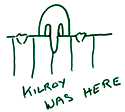 Introduction
Introduction
Veterans
Battles
Stamford Service Rolls
Homefront
Exhibit Photos
Opening Day


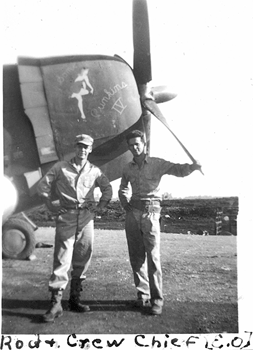
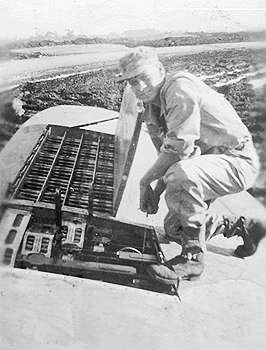
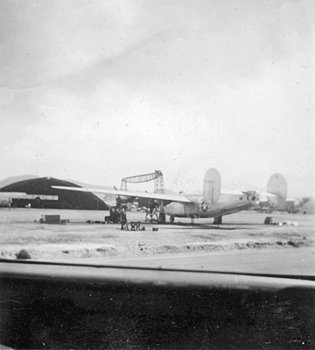
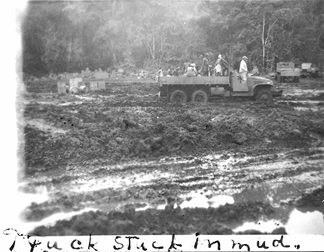
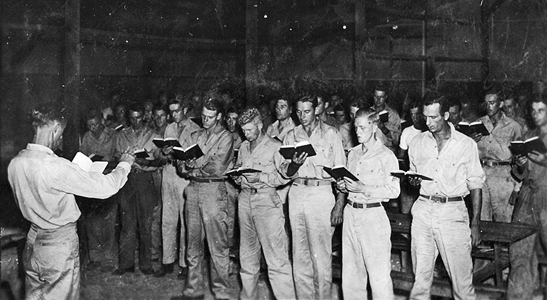
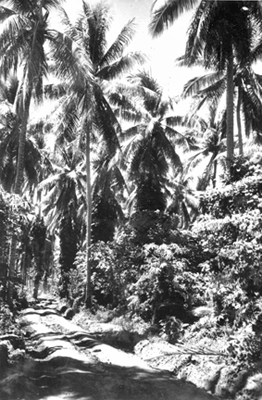
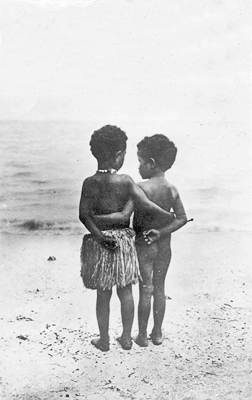
 Introduction
Introduction First of all what were you doing before you entered the service?
First of all what were you doing before you entered the service? Tape lost…
Tape lost…